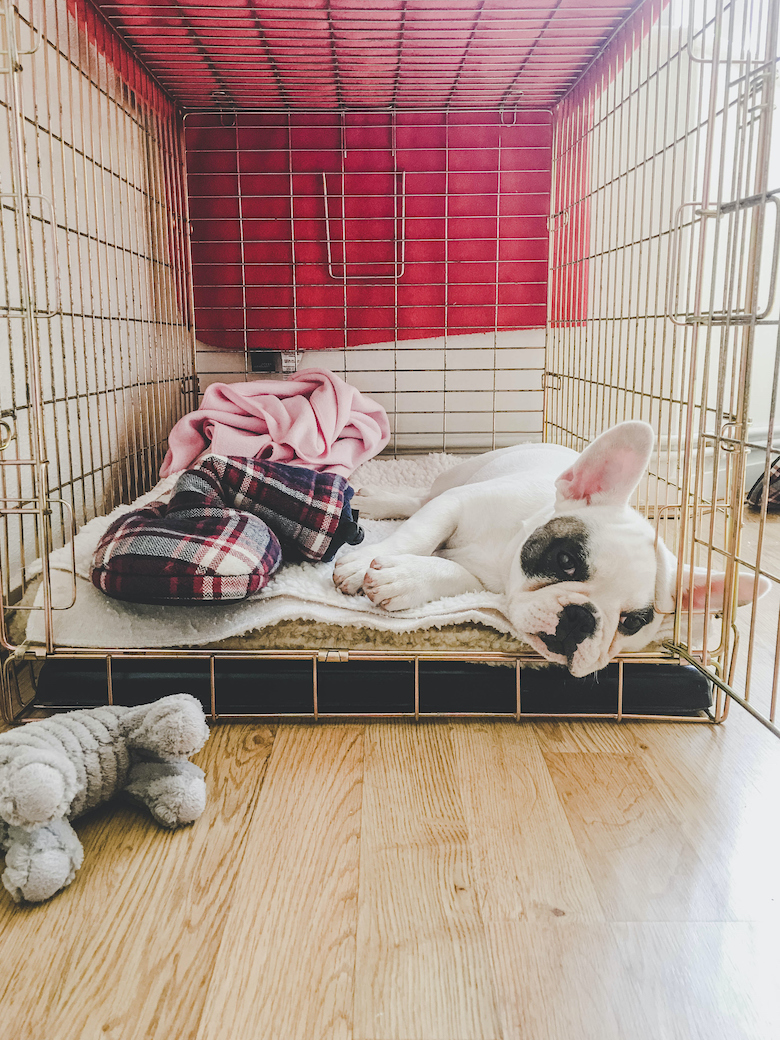Gone are the days when standard advice was to ignore a crying puppy. “Ignore him,” we said, “until he stops crying. If you go to him while he’s crying, you’ll reinforce him and teach him to cry more.” That’s horrid advice and I regret that ages ago I was guilty of saying it to clients.
Now that competent, educated dog training and behavior professionals have a much better understanding of the science of behavior and learning, we won’t tell you to ignore your pup’s cries. You must take action when your pup is in distress. That’s what his cries are – he’s communicating to you that he’s distressed – sometimes very distressed. (Note: This does not apply to “demand barking” – that requires a different response.)
While some puppies survive having their cries ignored and grow into normal, healthy adult dogs, others suffer with stress-related behavioral issues for the rest of their lives, including separation anxiety, due at least in part to not having their needs met when they were so desperate for help. So what should you do when your puppy cries? He’s crying for help. Help him.
Why is puppy crying?
When a puppy arrives at his new home, his world has turned upside down. His mother and siblings are gone. The familiar sights, sounds and smells of his birth home are gone – replaced with an alien environment. Even if he came from a responsible breeder who helped prepare him for this life change (sadly, a small percentage of possible puppy sources) the stress of rehoming may still trigger distress behaviors.
It’s critically important to take things slowly. Your pup may have never been alone before, ever. Being left alone now could be horribly traumatic, especially if you ignore his pleas for help. Your best approach is prevention. Assume your pup has never been crated or left alone, and plan on staying near him at first. Even if he has been previously crate-trained, the stress of relocating to your home can contribute to panic attacks.
How to help your puppy
Whether you are faced with a newly-arrived puppy or one who’s been in your home for a while, here’s what you need to do:
- Why is he crying. What’s stressing him? After identifying his stressor(s), figure out how to make them go away. (Go to: https://qa.whole-dog-journal.com/training/stressed-out/)
- Anticipate when he’s likely to stress-cry, and pre-empt the crying by engaging him in some other activity, food toy, or providing company.
- Keep him near you, and gradually acclimate him to being alone. Isolation is a huge stressor for a puppy!
- Spend time acclimating him to his crate by playing crate games, preferably starting with his first day home (but it’s never too late). (Go to: https://qa.whole-dog-journal.com/training/dog-crate-expectations/)
- If he is stressed by crating, use an exercise pen alternative (a collapsible wire pen) for confinement.
- If you cannot determine his stressors and alleviate his crying, engage the services of a qualified professional force-free behavior consultant to help you, sooner, not later.
How to get a puppy to stop crying at night
A pup’s first night home can be make-or-break time. If he adapted well to his crate during your first-day crate games, you can probably crate him in your room for the night. Do not, under any circumstances, crate him away in a room all by himself. You have to hear him when he cries to go to the bathroom. Get up and take him out. Crating him in your room also saves him from feeling abandoned. If he’s stressed about the crate, use an exercise pen that you can set next to your bed with your arm draped over the edge if necessary, to assure him he’s not alone.
Give him a good bout of puppy playtime before bed, a last bathroom trip and time to settle before the two of you retire for the night. Have his crate or pen where he can see you. A microwave-heated towel can provide comfort for him. He may fuss for a moment or two. As long as it doesn’t escalate and he settles quickly, you can ignore brief fussing. If it starts increase to distress crying, intervene. Hang your hand in front of his crate or into his pen so he has company. Over time (days, weeks) you should gradually be able to remove your hand without causing distress.
The same philosophy holds true for other times, long after your first night is behind you – in fact, for the rest of his life. A distressed, crying dog needs to be helped, not ignored. Figure out why he’s upset, and determine what you need to do to alleviate his stress. Intervene when he’s distressed. He’s crying for help. Help him.
Read Next: Socializing Your Puppy







I was given the same advice about my infant daughter. I tried to ignore her, but in the end I just couldn’t. I would lay down next to her, rub her back, and sing her songs. Until she was a teenager. Now 32 years later, she is a well adjusted adult without as lot of baggage. Dogs are a lot like people in so many ways!
My best dog slept on the bed from the time he was a puppy,
I started out in a living room chair for each night. When he needed a potty break it would awaken me. I’d put him through the doggy door very gently and he came back in the same way. Doing that I killed 2 birds with one act. Jazz potty trained & doggy door trained like a dream.
Noty much later I put him on the bed with me & my husband. I felt that it would be easier to tell if he needed a potty break. Sure enough he’d start milling around which would wake me up and I’d let him out.
And he kept my feet warm.
When I got my pup at 8 1/2 weeks, I had a little pen put in the kitchen, where we were most of the time, and spent lots of time with her. Also, I purchased a
“Cuddle Pup” with a device inside that has a battery making the sound of a beating heart. It was bigger than her, and she cozied up to it every night. I would wake her up at night to take her out until she was old enough to make it through the night. She sleeps with us now and has since she was about 5 1/2 months. So sweet.
That Cuddle Pup was wonderful, best $$ I ever spent. She never slept alone.
I had a baby gate from the kitchen to living room so she could be out with us when she was very little and not get where rugs were.
She is a happy, beautiful little Cavalier, who loves everyone, every dog, person and child. She never meets a stranger! I love her so much. Dogs are very emotional beings and need lots of love and positive reinforcement. And company.
We’ve always had our dog in the same room with us at night. First night home my hubby had his hand in puppy’s basket so he knew we were there. Never had a problem with him crying at night. He was crated in our room at night and slept right through.
When we got our puppies I put them on the bed with us. I do not know if this is a good idea but we did not have a crying puppy for the first few nights Then I put a crate right by our bed and slowly introduce them to the crate. When he or she woke up in the night I even took them out to potty. Brought them back, put them into the crate. Eventually they moved into kitchen and slept in a crate until they were old enough to be trusted to slept in the kitchen. I have the crate in the kitchen, for me it has been the best way to socialize them We have a 18 month old Shiloh Shepherd and she is a sweetheart!
Thanks Pat. There is some awful advice still kicking around regarding how to manage distressed puppies. Unfortunately such advice is often given out by well-meaning individuals on social media & trainers that have not upgraded their skills in a very long time. We will share your article and hope the general public start to get the message!
With my last two dogs (10 years apart), I did have their crates in my bedroom, with blankets carrying scents from their respective moms, etc. I admit, for each, I caved! Their plaintive cries cut through my heart and I couldn’t bear it. They each spent their first night in my bed — after some happy wriggling and licking, they settled down and slept until I took them out for their pee’s.
Took only one night, and after that, they slept in their crates still close to me. I did tire them out right before they slept, which really helped.
But yes, that warbling puppy cry will get me every time!
Thank you for this article! When we got our Golden Retriever, Yuko, in Feb 2020 I was concerned about the night times. Though I received advice to let her cry it out I was determined not to have a repeat of my experience in 1995 doing just that. Having raised two human babies since my poor poodle puppy suffered from my lack of experience, the family took turns in a sleeping bag in our bedroom, right up against the crate/pen enclosure for Yuko. She had a litter box and free access to water. I’m so grateful to her breeder/whelper for going to the trouble of litter box training the whole litter before we picked her up! We woke up to thank her for using the litter box in the night and to scoop poops. In a few weeks we removed water at night. A few months later we ousted the litter box. By one year she sleeps in the crate, happily, no xpen and we never had to let her cry it out.
We traveled about 4hrs to pick up our new Shichon puppy (half shi tsu and half bichon frise). When they brought her out and she saw her groomer…she was so excited. The groomer brought her over to us and she was suddenly quiet. I was a total stranger to her. As we started back on our trip back home she began to shake. She was obviously stressing. I began to hold her to my neck and whisper to her while very gently rubbing under her hanging ears. Almost immediately she calmed and stopped shaking. As we stopped a couple of hours later she was animated and explored her surroundings She is abt a year and a half now…She is happy and smart as a whip. She sometimes gets VERY animated so I pick her up and I talk softly to her while rubbing her ears and the forehead. It still calms her and even puts her to sleep with her head erect. I used to do this with my babies. Gently rubbing the area just above their eyebrows…Babies went right to sleep! Babies and puppies need the same thing.
Thank you very much for your nice blog. There is some advice to manage your puppy when they crying. Unfortunately, such advice is often given out by well-meaning individuals on social media so that they upgraded their skills in a very long time. So I will share your blog so that you get proper help….
When your puppy is crying, they take care smoothly that you provided this information in your blog. Thank you very much for your beautiful blog….